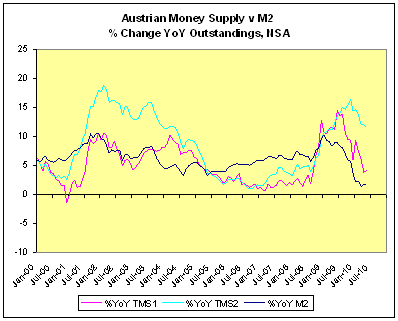Inflation Update
Steve Saville
email: sas888_hk@yahoo.com
Jun 22, 2010
Below is an excerpt from a commentary originally posted at www.speculative-investor.com on 20th June, 2010.
Money Supply Update
The best web-based presentation of US money supply data is located at http://trueslant.com/michaelpollaro/austrian-money-supply/. That's where we obtained the following chart, which shows the year-over-year (YOY) percentage changes for TMS1, TMS2 and M2. Note that "TMS2" is what we normally refer to as TMS (True Money Supply), whereas "TMS1" is a narrower definition of money supply that doesn't count savings deposits.

There has been a lot of figurative hair-pulling over the belief that the US money supply is falling, but this is only because the focus has generally been on flawed measures of money supply that include credit instruments in addition to money. When proper measures are used (reasonable arguments could be made in favour of either TMS1 or TMS2 in this regard) it becomes apparent that the US money supply is growing more slowly now than it was six months ago, but is still growing. Not only that, based on TMS2 it is still growing at a double-digit pace.
By the way, even if the US money supply were shrinking it would be a bad idea for the Fed to inject more money into the economy. Creating money out of nothing always causes problems, even if done in an effort to counteract monetary deflation. The reason is that the new money doesn't get spread evenly over the economy; rather, it enters the economy at discreet points, causes some prices to increase relative to other prices, and benefits some individuals and economic sectors (the early receivers of the new money) at the expense of others. It therefore leads to a greater number of ill-conceived investments, more resources being wasted, and the transference of wealth from the later to the earlier users of the new money.
Inflation and Relative Scarcity
Over the long-term almost all parts of the economy are hurt by monetary inflation (creating a lot of money out of nothing), but over timeframes of a few years or less there are winners and losers. It is usually difficult to forecast who will win and who will lose, although one way of identifying the most and least likely beneficiaries is to look at relative scarcity. In particular, all else remaining equal the parts of the economy where there is a lot of excess capacity are less likely to benefit from inflation than are the parts of the economy where supply is constrained or that are operating at close to full capacity. This is a large part of the reason why commodities did not benefit in a big way from the monetary inflation of the 80s and 90s but were amongst the main beneficiaries of the past decade's inflation.
The relationship between relative scarcity and monetary inflation goes a long way towards explaining why counter-cyclical monetary policy creates far more problems than it solves. When boom turns to bust, the central bank invariably slams its foot onto the monetary gas pedal in an effort to support the parts of the economy that are performing the worst, but these are the parts of the economy where there will usually be the greatest amount of excess capacity. In other words, the central bank tries to use inflation to boost the economic sectors that are amongst the LEAST likely beneficiaries of the inflation. This is why efforts to 'pump up' the weakest sectors invariably lead to new bubbles -- and whole new rounds of mal-investment -- elsewhere.
In the US economy at this time, excess capacity is most apparent in the labour market (there is a lot of unemployment and under-employment) and the property market (the current and potential future supply of residential and commercial property is weighing heavily on prices). In response to high unemployment and the weak real estate market the Fed seems determined to maintain an exceedingly loose monetary policy. But as discussed above, this cannot possibly help. Take the example of the labour market. The unusually high level of excess capacity in this market ensures that it will not be a beneficiary of inflation. Instead, a likely consequence of the loose monetary policy will be an increase in the cost of living relative to the cost of labour, meaning a general decline in real wages and greater hardship for wage earners.
On a related matter, there can be no such thing as a "wage-price spiral" or any other economy-wide price spiral in the absence of continuing money-supply growth. If there's a large one-off injection of new money then some prices will rise in response to the greater supply of money, and eventually -- probably after a few years -- most prices will move to a higher level than they would have been in the absence of the new money. However, higher prices cannot bring about higher prices in a never-ending loop unless the supply of money continues to ramp up.
We mentioned above that the labour market is more likely to be hurt than helped by the Fed's easy money. What sector of the economy, then, is likely to benefit?
Energy (oil, gas, coal, and fossil-fuel alternatives such as uranium, wind and solar) could benefit, but the only long-term upward trend in which we have a lot of confidence at this time is in the gold market.
###
Steve Saville
 email: sas888_hk@yahoo.com email: sas888_hk@yahoo.com
Hong Kong Regular financial market forecasts and analyses are provided at our web site:
http://www.speculative-investor.com/new/index.html. We aren't offering a free trial subscription at this time, but free samples of our work (excerpts from our regular commentaries) can be viewed at: http://tsi-blog.com
Copyright ©2002-2019 speculative-investor.com All Rights Reserved. Saville Archives
321gold Ltd

|

